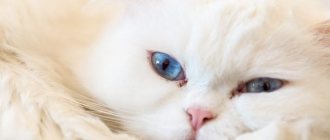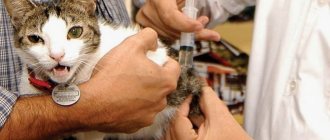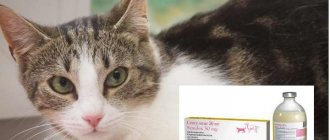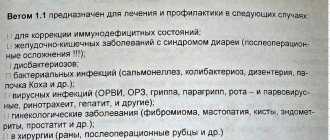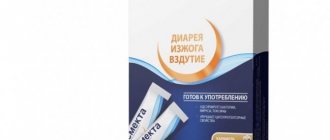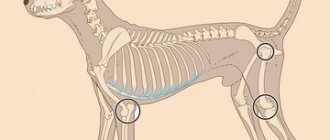Chemical composition of the drug "Amoxoil retard"
The product contains the active ingredient amoxicillin (trihydrate) in an amount of 150 mg. It is supplemented by excipients: aluminum monostearate in an amount of 1.5 mg and ethyl oleate - 1 ml.
Did you know? The ancestors of all breeds of domestic cats are 5 subspecies of steppe cats. The domestication of animals supposedly occurred 9.5 thousand years ago in the Middle East. Scientists believe that man's goal in taming cats was to protect leftover food from rodents.
The principle of action of the drug
When used correctly, the drug suppresses gram-positive and gram-negative microorganisms, in particular, Campylobacter, Clostridia, Escherichia, Listeria, Staphylococcus, Streptococcus, Salmonella, Pasteurella and other pathogens of bacterial infections.
Did you know? Today, the oldest evidence of cat domestication is the remains of an animal discovered by archaeologists on the island. Cyprus and dating back to 7500 BC. e. The pet was buried with its owner.
When administered by injection, the concentration of the active substance in the blood is achieved after 2–3 hours. The therapeutic effect lasts 2 days.
The substance is not metabolized in the body and is excreted unchanged during urination and bowel movements.
Description of the drug Amoxicillin
Amoxoil Retard is an effective complex pharmacological drug with a complex, wide spectrum of action.
Has a prolonged effect. In traditional veterinary medicine, it is used in the treatment of bacterial and viral diseases in cats. Amoxoil is available in the form of a sterile injection solution. Packaged in glass or plastic bottles of 50, 100, 250 ml, which are placed in cardboard boxes. The solution has a rich dark yellow color. The international nonproprietary name of the drug is amoxicillin.
The main active ingredient is amoxicillin trihydrate, which belongs to the group of semisynthetic penicillin antibiotics. Used for intramuscular, subcutaneous administration. The maximum concentration of the antibacterial drug in the blood and tissues of animals is observed two hours after injection. The therapeutic effect lasts for two to three days. High level of antibiotic, which persists for 2-3 days. The drug has no irritant effect and is well tolerated by animals. Belongs to the group of moderately toxic medications.
Amoxoil Retard – sterile solution for injection
Store Amoxoil retard in a cool, dry, dark place in closed cardboard boxes at a temperature of 0-22 degrees Celsius. The shelf life from the date of release is two years, but only if the storage conditions specified on the packaging are observed. After opening the bottle, use the solution within two days.
The universal veterinary antibiotic Amoxicillin, part of the penicillin group, is used to treat a wide range of infections in farm animals and pets, except rodents. It was developed by Spanish pharmacologists from the company Invesa, but has recently been produced in Russia. The drug gives good results in the complex treatment of cat diseases.
Amoxicillin is a proven drug for treating infections in cats.
The active ingredient of the drug is amoxicillin trihydrate - this compound is presented in different forms of the drug of the same name with different concentrations.
Amoxicillin is offered by its manufacturers in three forms:
- tablets - in blisters of 10 pieces or glass jars of 24 pieces;
- suspension - in glass bottles of various volumes;
- powder - in packages from 50 grams to 25 kilograms.
The tablets are taken orally, and the oily, light yellow suspension is injected; the powder is added to food or drink. Only tablets or suspension are suitable for treating cats.
Excipients of the suspension are:
- butylated hydroxytoluene,
- benzyl alcohol,
- aluminum monostearate,
- fractionated coconut oil.
The composition of Amoxicillin tablets is slightly different from the suspension - they additionally contain clavulanic acid. This substance enhances the effectiveness of the drug when taken orally.
Amoxicillin tablets contain an excipient - clavulanic acid.
The mechanism of action of amoxicillin trihydrate is simple and effective. This substance, entering an organism infected with pathogenic microflora, immediately begins to act: it destroys the cell membranes of bacteria and blocks the synthesis of enzymes necessary for the replication of their DNA.
Amoxicillin has a destructive effect on the following types of pathogens:
- streptococci;
- staphylococci;
- enterococci;
- Leptospira;
- salmonella;
- coli;
- listeria;
- proteas;
- clostridia.
The injection method of treatment gives better and faster results than pill therapy. With intramuscular or subcutaneous infusion of the suspension, Amoxicillin is immediately absorbed directly into the blood, which delivers the medicine to all organs and tissues. The required concentration of the active substance is achieved one or two hours after the injection.
Indications for use of the drug
Amoxoil retard is prescribed for the following health problems:
- upper respiratory tract infections (bronchitis, pneumonia, rhinotracheitis);
- urinary tract infections (cystitis, urethritis);
- gastrointestinal infections (gastroenteritis);
- atrophic rhinitis;
- other infections whose pathogens are sensitive to amoxicillin.
Instructions for use of the drug in veterinary medicine
The dosage of the drug for animals is calculated based on a dose of 15 mg of active substance per 1 kg of live weight, or 1 ml of the drug per 10 kg of body weight. The maximum dose that can be used at one time is 5 ml.
Important! It is necessary to use the drug only after consultation with a veterinarian, who should describe the dosage, frequency and frequency of administration.
The product is administered subcutaneously or intramuscularly with a disposable syringe. Usually the injection is given once. If necessary, a second injection is given after 48 hours. Before drawing the product into the syringe, shake it well to obtain a homogeneous mixture. Mixing several drugs in one syringe is strictly prohibited.
Injections are given to cats subcutaneously or intramuscularly, then a light massage is performed at the injection site to prevent an abscess and rapid resorption of the drug. The person administering the medicine must adhere to personal safety rules. Before and after using the drug, you should wash your hands with soap. If the product gets on the skin, rinse the area with plenty of water. If the drug enters the body, you should immediately seek medical help.
Video: how to give an injection to a cat
What does amoxicillin help for cats?
This antibiotic does a lot; it actively fights the following parasites:
- coli;
- staphylococcus;
- streptococcus;
- and other bacteria.
Veterinarians prescribe it for infectious diseases and inflammations, as well as in cases of complications of these ailments.
It plays an important role in treatment so that the pathogen is as sensitive as possible to this medicine. Therefore, it is very important to visit a veterinarian before your appointment.
If he prescribes this drug, he must decide on the dosage. And then tell the owner what it should be like.
The instructions for use contain all the important points that the owner must familiarize himself with, especially if he forgets what the veterinarian said.
READ Signs of pregnancy in a cat: how to determine it yourself
Side effects and contraindications
The drug is classified as moderately dangerous. It was assigned the third hazard class. Contraindications to the use of the drug include individual intolerance to the active substance or other penicillin antibiotics.
Find out what viruses your pet can catch.
Side effects in the form of depression, indigestion, swelling at the injection site can be observed if the dosage is incorrectly calculated and an excessive amount of the drug is administered.
Pharmacological forms and dosages
Amoxicillin is an antibacterial semisynthetic drug produced in Spain. The drug belongs to the group of penicillin antibiotics, which have a wide spectrum of action.
It easily dissolves in the place where the injection was made and spreads throughout the body, concentrating as much as possible in the liver, kidneys and muscles.
Thanks to the drug, the formation of the cell wall of microorganisms slows down, the synthesis of the enzymes transpeptidase and carboxypeptidase stops, and the osmotic balance is disrupted. This contributes to the death of pathogenic bacteria.
The active component, slowly released by the oily filler, ensures the long-lasting effect of the drug. The maximum concentration of the active substance in the blood is achieved 1–2 hours after administration, and the duration of the therapeutic effect is 48 hours. The drug is usually excreted unchanged through the kidneys.
Release form
Amoxicillin is available in three forms: tablets; powder for mixing with food or water; suspension (yellowish or white oily substance) for injection.
Most cat owners note that the last option is the most convenient to use. The difficulty in determining the exact dosage arises if you need to give an animal a tablet.
But if a powder is used that is mixed with food, then there is no guarantee that the cat will receive the required amount of medicine.
When using a suspension, the exact amount of the drug is drawn into the syringe, and the active substance immediately enters the blood, bypassing the digestive tract. The pill option is usually suitable for those cat owners who are afraid to give their animal an injection or are afraid of doing it incorrectly.
The drug is available in three forms:
- In tablets, the weight of which is 0.25 and 0.5 grams, and they can be packaged both in plastic jars (there are 24 tablets) and in plates (10 pieces each),
- As a liquid for injection, it has a white or white-yellow color. It is administered intramuscularly.
- In powder form. It must be mixed with water or food.
In what doses should I give the drug in tablets to a cat? Owners and some veterinarians do not like this form of release. Because it should be 12.5 mg per kg of animal weight. And calculating the dose is often difficult.
In some cases, there is a different dosage if the veterinarian considered it necessary to indicate this.
If we talk about such a form of release as injections, then the drug is available in bottles of 100 and 10 ml. Which is very convenient if your pet does not have a severe form of his disease, and he is prescribed only 1 to 3 injections.
Before giving your cat an injection, be sure to shake the bottle. It is also important to make sure that both the needle and syringe are completely dry. It is advisable for the cat to give a light massage to the future site of drug administration.
The drug can be bought in tightly closed glass vials of different volumes; it can be said to vary diametrically, from 10 to 250 milliliters.
The active substance contained in one milliliter of this liquid also differs, although not so much, 150 or 200 mg.
Typically, veterinarians use injections (15 percent solution). Of course, veterinary pharmacies sell suspensions for injections, but some experts do not recommend using it, because in their opinion, tumors may appear at the injection site, and also, in their opinion, because the procedure is unnecessarily painful.
Storage conditions
As the manufacturer indicates, the drug can be used within 2 years after its release if the bottle is not opened. After opening the bottle, its shelf life is 48 hours. The drug should be stored indoors, at a temperature in the range of +4...+25°, without humidity or exposure to sunlight.
It should not be accessible to children and pets, and should be kept away from food and drinks. Used bottles must be disposed of and cannot be reused.
Reviews of the drug from cat owners and veterinarians
This again depends on what form the medicine is taken in.
If the injections are for intramuscular administration, then the likelihood that the cat will receive an “overdose” of the medicine is extremely small.
By the way, after administering the injection, you need to lightly massage the injection site. That is, both before and after administration. If in powder, then, in principle, too. The dose is easy to calculate.
But if you use it in tablets, an overdose is very likely. Because it is extremely difficult to calculate the weight of the tablet and correlate it with the weight of the animal.
It should be recalled that the proportion of antibiotic in tablet form is 12.5 milligrams per 1 kilogram of kitty weight. And if the weight of the animal is small, for example, we are talking about a kitten, choosing the correct dosage of the medicine is very difficult, so it is better for the owner to use solutions or injections.
READ Is it possible to spay a cat during heat and pregnancy?
There is no need to self-medicate your cat; it is even strictly prohibited, since any antibiotic, including the one in question, has its own side effects. The most common manifestation is allergies. The place where the injection was administered may well become swollen, red, and conjunctivitis may begin to develop.
If the situation is more severe, allergies may develop. If there is a hint of these reactions, the drug should be discontinued without delay.
Side effects include vomiting (possible), very severe diarrhea, and the cat’s taste preferences may change dramatically.
Rarely, but still there have been cases of even ulcerative stomatitis due to the fact that the cat took this medicine. The animal's behavior may also change. He may have a slow reaction or overly excited behavior.
Taking the drug in form can lead to sensations of pain at the site of drug administration, and the cat begins to walk with a limp. Difficulty breathing and hoarseness can be observed in a number of animals. Long-term and unnecessary use (i.e., without the knowledge of the veterinarian) of an antibiotic can give rise to the development of fungi in the mouth and even diseases of the genital organs.
Do not prescribe treatment with Amoxicillin yourself; be sure to show the sick animal to a doctor. Amoxicillin is a strong antibiotic and should be used in such a way that the treatment brings maximum benefit and minimum harm to your cat.
